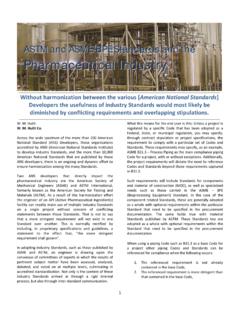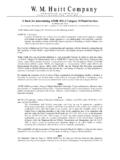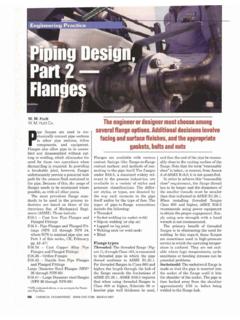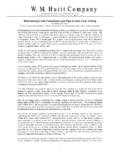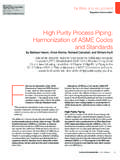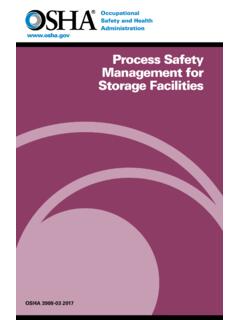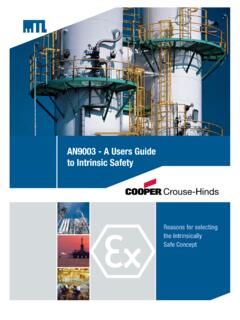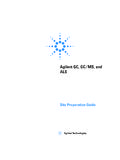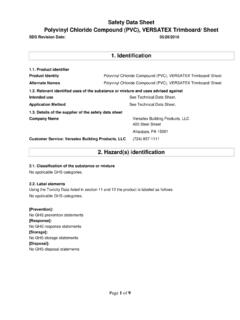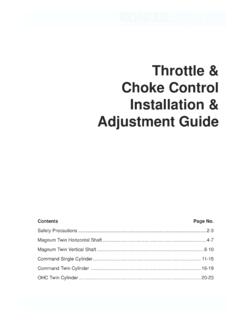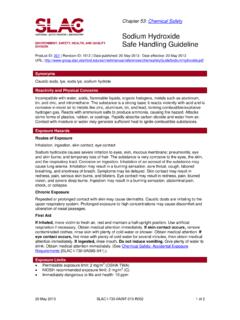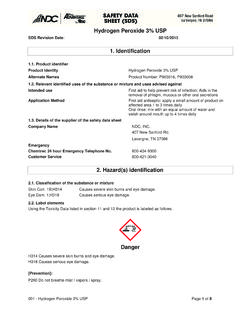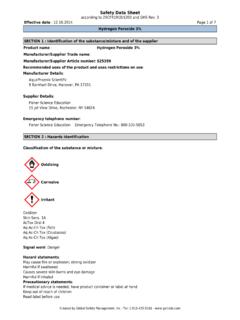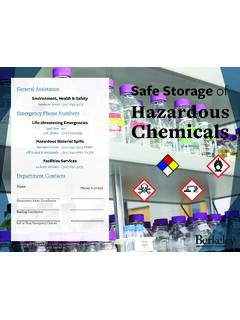Transcription of Piping material for hydrogen service - W. M. Huitt Co
1 P O B o x 3 11 5 4 S t . L o u i s, M O 6 3 1 3 1 - 0 1 5 4 P h o n e : ( 3 1 4 ) 9 6 6 - 8 9 1 9 ~ E m a i l : w m h u I t t @ a o l . c o m 1 Piping material for hydrogen service by William M. Huitt (From a paper dated February 21, 2001 in response to a discussion on material for hydrogen Piping .) With regard to Piping material selection for gaseous hydrogen service there are two main considerations, aside from the basic criteria for determining ASME pressure classification and pipe material .
2 Those two considerations are hydrogen attack and the high degree of concern with regard to leak potential. Carbon steel is acceptable for use in hydrogen service when operating temperatures remain below 500 F. hydrogen attack occurs when hydrogen is contained under high partial pressure in combination with high temperatures. When the partial pressure of hydrogen is expected to be approximately 200 PSI, at temperatures above approximately 500 F, carbon steel is not recommended.
3 As you can see by the modified Nelson diagram, Fig. 1, as taken in part from API 941, elevated temperatures have the greatest effect in contributing to hydrogen attack. In selecting carbon steel with operating temperatures below 500 F, the partial pressure of hydrogen can exceed 3000 PSI (not indicated on chart) with little concern for hydrogen attack. Fig. 1 Nelson diagram API 941 This diagram indicates the choice of steel warranted to avoid hydrogen attack as a function of operating temperature and partial pressure of hydrogen .
4 Austenitic materials are satisfactory at all temperatures and pressures from hydrogen damage. Issues and Recommendations When referring to leak points in a Piping system we are referring to mechanical type joints such as a flange joint, threaded joint, valve body seal, and valve stem packing. Since hydrogen , with a molecular weight of 2, has such a high propensity to leak, with potentially devastating results, it is imperative that a Piping system be designed to limit those leak points, and to provide a high degree of assurance for those possible leak points that cannot be avoided.
5 In an effort to limit potential leak points it is suggested that a Piping system be entirely welded with the exception of flanged joints at equipment and/or valving. Threaded joints should typically be avoided with 2 pipe to pipe joints buttwelded. Carbon steel should be post-weld heat treated. After welding, pipe within the heat-affected zone (HAZ) becomes susceptible to hydrogen attack, even at ambient temperatures. And while hydrogen attack mainly occurs at elevated temperatures this step will reduce, if not eliminate, that possibility entirely.
6 The weak point in an all welded system will be the flange joint. In order to provide a high degree of integrity at flanged joints a gasket that consists of a serrated solid metal ring sandwiched between a soft, deformable sealing material as shown in Fig. 2. The serrations concentrate bolt load on a smaller area to provide a tighter seal at lower stress. Its design allows the gasket to compensate for irregularities in the flange surfaces as well as fluctuations in service conditions.
7 Fig. 2 Suggested Gasket Design Another consideration in system integrity is the valving; Leaks around valve stem packing is a real concern. In an effort to prevent this, the selection of bellows seal valves and/or diaphragm valves is recommended. System Pressure Rating Using a 1" sch. 80 carbon steel pipe per ASTM A106 Gr B with a corrosion allowance of ", the maximum allowable working pressure can be calculated for temperatures below 400 F using eq. 1: Eq. 1: Where: Pa = Maximum allowable internal pressure for straight pipe S = Maximum allowable stress for the material at design temperature (psi) Do = Outside diameter of pipe (inches) y = Coefficient.
8 For ferritic steel in temperatures below 900 F. t = Specified wall thickness minus mechanical and corrosion allowance and manufacturing tolerance. 4 = Safety Factor Therefore: For a 1" sch. 40 pipe, using the same criteria, the results would be: The and 523 psig maximum allowable working pressure applies to the pipe only. The flange joints will be the governing factor in determining the allowable pressure for the system. Based on ASME , at temperatures from -20 F to 100 F, the Class 150 carbon steel flange joint has a maximum allowable working pressure of 285 psig.
9 Class 300 has a maximum allowable working pressure of 740 psig. This will be the limiting factor for the system as per the following specifications. 422ytDStPoaMAWP psig )(burst ,202aPMAWP psig 5234pressure(burst ,202aP 3 Basic Specification A pipe spec for gaseous hydrogen service operating at ambient temperatures with design pressures below 740 psig might consist of the following material requirements: Pipe Sch 80, , ASTM A106 Gr. B Fittings Sch. 80, , , ASTM A234 Gr. WPB, ASME Flanges Welding neck, , ASTM A105, ASME , 150/300 Class Bolts Stud bolts, ASTM A193 Gr B7, with nuts, ASTM A194 Gr 2H Gaskets " thk.)
10 316 SS serrated solid metal core, with spiral wound flexible graphite both sides, and integral centering ring. Valves: Gate or flanged, bellows seal gate valve, welded bonnet, stainless steel bellows, test port. Globe or flanged, bellows seal globe valve, welded bonnet, stainless steel bellows, test port. Check (Not recommended) Examination, Installation and Testing Examination should include 100% radiograph of all welds. Installation should minimize or eliminate the use of breakout flanges.
